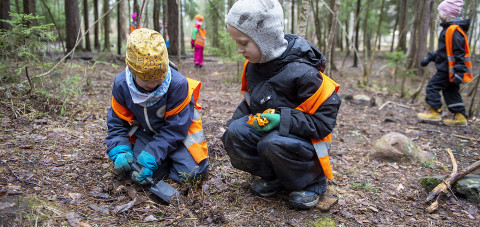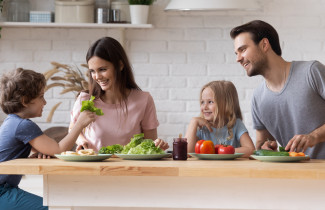In order for children to have an uncomplicated relationship with food, it is good to start building a balanced food relationship in already in early childhood education.
“The foundation of one’s relationship with food is built in childhood. Therefore, the way we talk about food with children, what we teach about it, and what our attitude towards it is, matters,” says Sanna Talvia, University Lecturer in Home Economics.
Earlier, food education used to rely heavily on top-down information, but the approach is now moving in a gentler direction. It is based on the idea of accepting people as individuals and realising that we all have our own history and relationship with food, as well as our taste preferences.
“After World War II, food education and communication were based on instructions aimed at preventing chronic diseases caused by an abundance of food. This has taught us to keep an eye on our weight and to think of food as either ‘healthy’ or ‘unhealthy’.”
With this categorisation of foods, we have also started to culturally categorise people: anyone who eats healthy is a good person – and vice versa. Moral undertones have also gradually crept into healthy eating, in some cases laying the foundation for a more complicated food relationship and even problems in eating behaviour.
“The underlying objective of our ongoing Ruokakunta project is that, with more permissive food education, children will form a more straightforward and balanced relationship with food already in early childhood education,” says Talvia.

Well-functioning practices for municipalities
The project, a joint initiative by the University of Eastern Finland’s researchers of early childhood education, home economics and clinical nutrition, as well as the Finnish Heart Association, has an interesting task at hand: it has taken an interdisciplinary approach to develop meals in early childhood education and food education in municipalities.
The goal is for the municipalities involved to consciously commit themselves to integrating meals and food education that support health and well-being into their basic activities.
“We currently have three regions and more than 10 municipalities participating. We have tried to involve municipal actors from a variety of sectors. This way, the municipality will have a common understanding of the level of food education in its early childhood education, and how it can be collaboratively developed further,” Project Coordinator, Nutritionist Kaisa Kähkönen explains.
The researchers have not wanted to go easy on the municipalities, but rather to create effective ways to make regional support available to municipal food education activities.
“This can be achieved when food education is integrated into the wider efforts to promote well-being and health both at municipal and regional levels, and there is a clear responsibility for coordinating the work relating to food education.”
The municipality should have a common understanding of the level of food education in its early childhood education, and how it can be collaboratively developed further.
Kaisa Kähkönen
Project Coordinator, Nutritionist
Food education in many areas
University Lecturer in Early Childhood Education Titta Kettukangas says that many people have been surprised by the comprehensive nature of food education.
“We rarely stop to think about how many areas of a child's life food affects. It is often thought that food is only about taking in nutrients and keeping hunger at bay, but in reality, it includes many moments of learning, social dimensions, and learning about habits and traditions.”
When talking about the matter with all the actors involved, it was ultimately agreed that supporting children's food education also supports the well-being and health of the entire municipality.
“It is also great that our meetings with people working in kindergartens have increased their understanding of their role in supporting food education in families. In the past, it was often thought that this is a task of maternity and child health clinics, but early childhood education plays a very important role because of its daily contact with the family.”
In early childhood education, food is almost continuously present: in the course of the day, children eat three meals, but food and food culture are also otherwise on the agenda through, for example, role play and picnics.

Food relationship as a resource
In order for children's food relationship to be balanced and positive, early childhood educators must comprehensively understand and internalise food education.
“In the past, people working in early childhood education didn’t necessarily have a common understanding of the matter. Instead, old traditions and set ways, sometimes even personal opinions, lurked in the background. Sometimes people don’t dare to look at things in a new way, or they don’t know how,” Kettukangas says.
Early childhood educators should, above all, examine and be aware of their own relationship with food.
“We have noticed that food education and its principles are easily looked at through one’s own food relationship, and this applies to both educators and other municipal employees. This is why everyone should stop and think about what their relationship with food is like.”
According to Kettukangas, this is particularly important when working with children.
“We urge educators to think about how their food relationship is reflected on their work – whether it is a resource or whether it narrows their thinking. What is the attitude towards a child whose food relationship is completely different from that of the educator? How to put oneself in the child’s position?”
According to Talvia, going through one’s own food relationship and understanding it gives professional strength. It makes the educator more humane and helps to understand the strengths and challenges of each child.
“This makes it possible for educators to better support families where support for food education is particularly needed.”
We urge educators to think about how their food relationship is reflected on their work – whether it is a resource or whether it narrows their thinking.
Titta Kettukangas
University Lecturer in Early Childhood Education
Solution-oriented activities
People working in the project are pleased about food education now being taken more seriously in several municipalities, and decision-makers have also attended joint meetings. The researchers hope that the model developed in the project would spread more widely and become part of municipal practices and service contracts.
“We offer municipalities several tools for this. Not everything needs to be taken into use, but each municipality can adopt solutions that are suitable for its situation,” Kähkönen says.
The project provides models for describing the objectives of good nutrition, good meals and good food education, as well as the forms of collaboration used in the municipality.
“The most obvious need in municipalities has been for our tool to assess meals and food education, which we’ve developed together with the Tasty School project. It is used to assess the current state of food education and meals in different municipal units.”
According to Kähkönen, the tool has revealed major differences between municipalities, and municipalities that have invested in food education clearly stand out.
“Of course, this is an asset for the municipality: it is easy to say that we support the well-being of our residents since early childhood.”
The project is also strongly collaboration-oriented when moving things forward. If, for example, a municipality has previous data on how many children skip school meals or how many children are overweight, the project will not stay fixed on these figures, but works together with the municipality to find concrete ways to address the issues.
“For instance, if a significant proportion of children in a municipality are overweight, we will work together to identify the underlying reasons, and how to move forward. We help to create indicators for food education, and support municipalities in their preparation of welfare reports and related entries,” Kähkönen says.
We hope that, in the future, the development of children’s food relationship can be supported more individually than before.
Sanna Talvia
University Lecturer in Home Economics
There are many good relationships with food
The researchers working in the Ruokakunta project hope that the joint discussions with, and the tools provided for the municipalities will support the establishment of a good food relationship for the next generation, as it is also otherwise reflected on residents’ well-being and functional capacity.
“We emphasise that there is not only one right food relationship, but many good ones. We hope that, in the future, the development of the different aspects of children’s food relationship can be supported more individually than before.”
Of course, it is comforting that one’s relationship with food can be changed even as an adult, although it is more challenging then.
“In any case, having a gentle attitude towards ourselves and towards the food relationship of other adults will improve the quality of life and compassion even later in life.”





